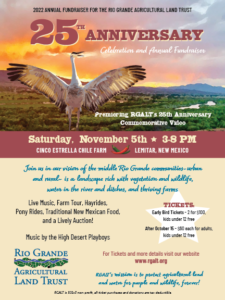It was 25 years ago, a diverse group of community members – farmers and conservationists – gathered at my kitchen table to discuss ways to protect farmland in Socorro County. The county was contemplating the establishment of a county zoning ordinance, potentially classifying agricultural land in ways that would limit landowner’s options, impacting private property rights. This initiated an in-depth discussion between the founding members of the organization about government imposing restrictions on private land. We wanted alternate and voluntary options to protect agricultural land and water, both of which are highly valued by Socorro County’s citizens. We learned about land trusts and conservation easements (CEs), a tool for protecting farmland and natural habitat forever. Through the support of land trust organizations around the country, RGALT received federal approval as a non-profit land trust in 1997 with a focus area that includes Sandoval, Bernalillo, Valencia, and Socorro Counties. Since then, RGALT has established itself as the middle Rio Grande land trust whose sole purpose is to facilitate landowners’ abilities to control the protection of their agricultural and natural habitat lands through their own initiative. For the first decade RGALT’s deeply committed volunteer board members focused on setting the groundwork for private land conservation. It was clear from the beginning that the only way to achieve landscape conservation was to build relationships and trust with landowners and in the communities and to establish partnerships with agencies, tribes, and other non-profits. Over the decades RGALT has had successful achieved bringing diverse and unlikely groups together to protect the lands we all cherish for widely diverse reasons. In 2004, RGALT finalized their first easement protecting farmland adjacent to Casa Colorada Refuge in Valencia County. By our 20th anniversary in 2017, RGALT had one staff, held 25 easements with several underway and received Land Trust Alliance Accreditation, an award given to land trusts meeting the highest national standards for excellence and conservation permanence. Fast forward, today, our 25th anniversary, RGALT has achieved accreditation renewal, employs 2.5 staff, and holds 29 easements, with funding secured for 6 additional CEs now underway, and 3 more CEs being developed. Accomplishing CEs is especially challenging in the MRG where the majority of agricultural landowners are socially disadvantaged and underserved. Supporting landowners’ conservation needs requires RGALT to seek conservation funding for these landowners, for both bargain sale purchase of CEs and to find ways to cover the CE transaction costs. Local, state and federal conservation funding is limited or non-existent to protect these high value lands, under extreme development pressure – lands that not only provide food but are critical wildlife corridors. Yet with limited funding sources, RGALT has been able to secure funding for 90% of our CEs that without funding would not have happened. Providing landowners with conservation funding provides landowners, especially land rich, cash poor, an opportunity to realize part of the land asset and offers an alternative to selling their land and water rights. Conservation success is often measured in numbers – number of easements, number of acres protected. RGALT’s success can be measured by our efforts to ensure equitable conservation for all landowners, not just for those wealthy enough to receive tax benefits – often newcomers. We work to serve the historic landowners, many who have inherited their family lands and whose families have been stewarding them for multiple generations. These landowners have a heart connection to the land and strong desire to see it remain in agriculture and to protect the historic water rights. They want to pass their land legacy on to their heirs but they cannot afford to donate a CE much less afford the CE transaction fees. Our success can be measured by the partnerships we have established over the years, more than a hundred partnerships. In the last decade alone RGALT alone, and with partners has been awarded $14.5 M in federal and state conservation dollars, with half of the funding for CEs and the remainder for restoration –this has resulted in more than 15,000 acres of threatened natural habitat, farmland, and wildlife corridors protected and/or restored. The MRG landscape is under dire threat due to growing urban and rural development, drought, water management shifts, water policies, and climate change. These are serious concerns identified by diverse communities, agricultural producers, environmentalists, historic tribal and Hispanic communities, acequia associations, water managers, migratory bird conservationists, wildlife managers, policymakers, and outdoor enthusiasts. Underserved landowners are more vulnerable to these pressures because land conservation is not economically feasible. Due to these threats, numerous conservation organizations have designated the MRG as a priority conservation focus area for protecting and restoring land. RGALT is developing new and expanding existing partnerships to address this issue in a more coordinated and effective manner. RGALT is a key partner in the landscape conservation effort, given our 25 years of establishing relationships and trust with landowners and our success in building bridges between landowners and conservation agencies – the key to conservation success. As RGALT’s director, I have experienced our conservation work to be far beyond a real estate transaction. We embark on a journey with each landowner on what is often a highly emotional transaction. Each one of our projects has a unique story and history behind it, stories that bind us like family. Each landowner’s project is a demonstration of their commitment and love for the land, family and their cultural heritage – and their desire to leave a legacy benefitting all of us – today and in the future.
505-270-4421
info@rgalt.org

